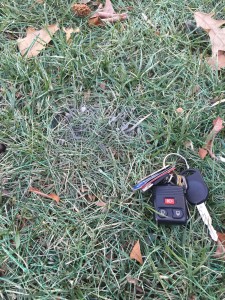(By Jared Hoyle, KSU Turfgrass Research and Extension)

Last year I wrote a post about some of the things I have learned while I have been in KS. One thing was how hard it is to grow turfgrass in the north-western part of the transition zone. And because it is hard to grow turfgrass here it is also hard to diagnose problems when they occur in our turfgrass systems.
So before we start talking about diagnosing turfgrass problems lets talk about how we are diagnosed when we are sick. So one day you wake up and you don’t feel good. You know your throat hurts, you have a fever so you go to the doctor. While at the doctor’s office the doctor asks you questions like what hurts?, when did you start feeling bad?, have you taken any medicine?, etc. So the doctor asks you questions to figure out what is wrong, Right? So you don’t just show up, sit down, and then say fix me. It is a process that you have to go through.
But after all the questions the doctor will prescribe you something to help you feel better. Maybe drink more fluids, get some rest, take some medicine, or all sorts of other remedies. So you go home and start doing what the doctor tells you. In about three days you still feel bad. So you go back to the doctor and start it all over again. And again you get your marching orders on how to feel better. This time it worked and you are better.
That’s how we have to approach issues when they occur in turfgrass. So many times I get a fuzzy picture and the question, “Why is my grass dead? Fix it!” This is just like showing up at the doctor and saying “Fix me”. So to properly diagnose a turfgrass issue some basic information is needed.
- What type of turfgrass do you have?
- What type of soil do you have?
- Is it a weed, disease, insect, or other issue?
- When did you first see what was going on? What time of year? How long has it been going on?
- Do you or someone else take care of the turfgrass? If someone else what do they do to the turf?
- What chemical or cultural practices have recently been conducted?
- What type of pattern is the damage? (uniform or random)
- Any other information?
I would recommend to have as much of the information as possible if you are really trying to figure out what is going on. This way you can diagnose the issue quicker instead of having to go back and forth to finally get all the information for a proper diagnosis. That’s like having to go back to the doctor because the first diagnosis was incorrect because the doctor didn’t know all of the information.
Lastly, many times when you are gathering all this information, you end up solving the problem yourself!
***Mention of trade names or commercial products in this article is solely for identification purposes and does not imply recommendation or endorsement, nor is criticism implied of similar products not mentioned by Kansas State University.***
Don’t forget to follow me on twitter @KSUTurf.
Also, visit our facebook page http://www.facebook.com/KSUTurf
